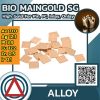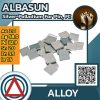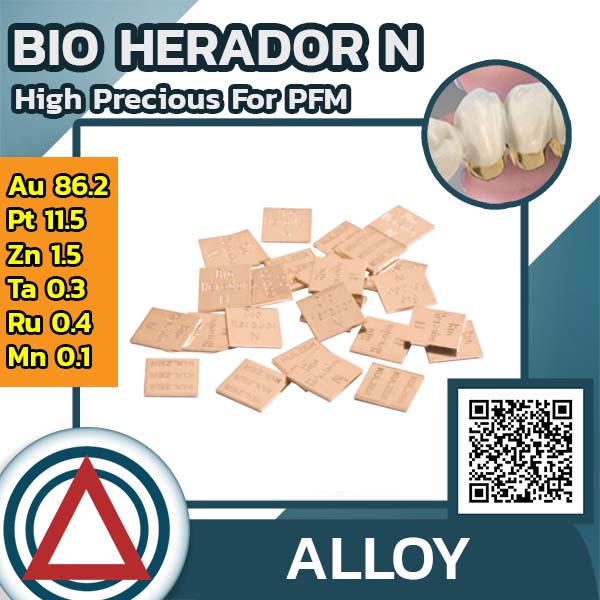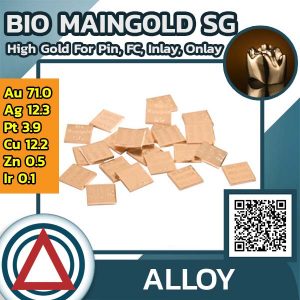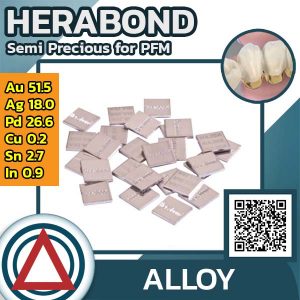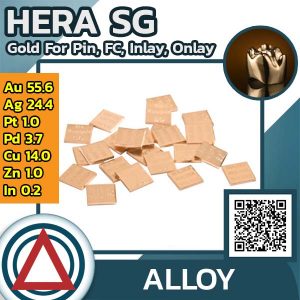Bio Herador N (ราคาปรับตามราคาตลาดโลก)
High gold content ceramic bonding (สีเหลือง)
alloy acc. to EN ISO 9693-1 and22674
ข้อได้เปรียบ
– มีส่วนประกอบของ Gold อยู่ 86.2 mass % (ส่วนประกอบของ precious-metal 98.1 mass %)
– ใช้กับงาน milling ได้
– ไร้ส่วนประกอบของ Palladium และ copper
– Thermal shock resistance สูง
– มี Corrosion resistance ดีเยี่ยม
– ใช้งานได้อย่างทั่วถึง ตั้งแต่ Crown ไปถึง Bridge ตั้งแต่ 2 ซี่ขึ้นไปยัน Bridge ที่มีความยาวสูงสุดก็ยังมีความแข็งแรงเป็นพิเศษ
ประเภทงานที่เหมาะ
– Single crowns
– Bridges
– Milling procedures
– Implants
แอดไลน์เพื่อสอบถามราคาและโปรโมชั่น
Add to Wishlist
Add to Wishlist
Description

Ceramic bonding alloy acc. to EN ISO 9693
|
|
| Type | 4 (s/ v/ k) |
| Shade | Yellow |
| Indication | 3,4,5,15A) |
| Composition | Au 86.2 Pt 11.5 Zn 1.5 Ta 0.3 Ru 0.4 Mn 0.1 |
Technical specifications, melting and casting |
|
| Melting range | 1050 ° – 1130 ° C |
| Preheating temperature | 850 ° C |
| Casting temperature | 1280 ° C |
| Crucible | Graphite |
| Hardness (HV5) | 205 (w/k), 220 (v), 185 (s) |
| 0.2 % yield strength (MPa) | 500 (w/k), 555 (v) |
| Elongation (%) | 6 (w/k), 5 (v) |
| Young’s modulus of elasticity (GPa) | 90 |
Ceramic firing |
|
| CTE | 14.3 |
| Oxide firing | 880° C/ 10 min. (vacuum, stripping) |
| Soft annealing | — |
| Hardening | 450° C/ 15 min. |
Solder/laser welding wire |
|
| Solder | Herador PF solder 1040, 1010 Herador/Maingold PF solder 800 |
| Laser welding wires | Ø 0.5 mm x 200 mm + Ø 0.3 mm x 200 mm |
x = content < 0.1 mass%
Indications:
1 Inlays, cervical filling
2 MOD Inlays
3 Crowns
4 Bridges
5 Milling technique
6 Partial dentures
10 Cast posts
14 Can be veneered with high expansion, low-fusing ceramics
15 Implant restorations
16 Electroformed double crown technique (primary crowns)
1 Inlays, cervical filling
2 MOD Inlays
3 Crowns
4 Bridges
5 Milling technique
6 Partial dentures
10 Cast posts
14 Can be veneered with high expansion, low-fusing ceramics
15 Implant restorations
16 Electroformed double crown technique (primary crowns)
Footnotes:
w = after soft annealing and quenching
k = ceramic bonding alloy: condition after ceramic firing
v = after hardening
s = self-hardening after slow cooling in the mould
w = after soft annealing and quenching
k = ceramic bonding alloy: condition after ceramic firing
v = after hardening
s = self-hardening after slow cooling in the mould
A = A stable framework design with reinforced connections with a cross section of 8 – 10 mm² is required for long span bridges and superstructures. Additionally, the frameworks need to be hardened.
B = Depending on the copper content, in some cases discolouration ofdouble crowns may result after short period of wearing. Discolouration, however, is technically and physiologically harmless.
C = In exceptional cases these alloys can also be used for traditional telescopic crowns with parallel walls and for the bar casting technique provided that cross-sections for crown walls, approximal areas, bars and laser welded joints are particularly thick and the alloy is hardened subsequently. No indication for conical crowns and sheardistributors.
B = Depending on the copper content, in some cases discolouration ofdouble crowns may result after short period of wearing. Discolouration, however, is technically and physiologically harmless.
C = In exceptional cases these alloys can also be used for traditional telescopic crowns with parallel walls and for the bar casting technique provided that cross-sections for crown walls, approximal areas, bars and laser welded joints are particularly thick and the alloy is hardened subsequently. No indication for conical crowns and sheardistributors.

